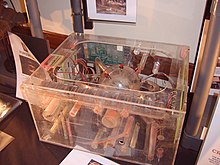An associate of mine banged this together at the local maker / hacker space. its quite elaborate, not expressed by the outside case. lots of interlocking laser cut acrylic.
http://likemagicappears.com/projects/raspberry-pi-cluster/



'Recently, I’ve completed construction of a 40-node computing cluster based on the Raspberry Pi single board computer. Below is a quick overview video, showing the finished product.
My goals for this project were as follows:
Build a model supercomputer, which structurally mimics a modern supercomputer.
All hardware required for the cluster to operate is housed in a case no larger than a full tower.
Parts that are likely to fail should be easy to replace.
It should be space-efficient, energy-efficient, economically-efficient, and well-constructed.
Ideally, it should be visually pleasing.
I feel I have met these goals with my design.
Here are the specifications of the final system:
40 cores Broadcom BCM2835 @700 MHz
20 GB total distributed RAM
5 TB disk storage – upgradeable to 12 TB
~440 GB flash storage
Internal 10/100 network connects individual nodes
Internal wireless N network can be configured as an access point or bridge.
External ports: four 10/100 LAN and one gigabit LAN (internal network), 1 router uplink
Case has a mostly toolless design, facilitating easy hot-swapping of parts
Outer dimenions: 9.9″ x 15.5″ x 21.8″.
Approximate system cost of $3,000. (The first one cost slightly more.)
Why Build It?
I needed a computing cluster that I could use for testing distributed software. Since I don’t have free access to a traditional supercomputer, I decided to build my own. Originally, I planned to create it as part of my MSCE thesis, but ended up with a different project for that. As a consequence, I pursued this as a personal project instead.
Since I was making a significant investment in this, I wanted it to be something I would be proud to show people for the next several years.'
http://likemagicappears.com/projects/raspberry-pi-cluster/



'Recently, I’ve completed construction of a 40-node computing cluster based on the Raspberry Pi single board computer. Below is a quick overview video, showing the finished product.
My goals for this project were as follows:
Build a model supercomputer, which structurally mimics a modern supercomputer.
All hardware required for the cluster to operate is housed in a case no larger than a full tower.
Parts that are likely to fail should be easy to replace.
It should be space-efficient, energy-efficient, economically-efficient, and well-constructed.
Ideally, it should be visually pleasing.
I feel I have met these goals with my design.
Here are the specifications of the final system:
40 cores Broadcom BCM2835 @700 MHz
20 GB total distributed RAM
5 TB disk storage – upgradeable to 12 TB
~440 GB flash storage
Internal 10/100 network connects individual nodes
Internal wireless N network can be configured as an access point or bridge.
External ports: four 10/100 LAN and one gigabit LAN (internal network), 1 router uplink
Case has a mostly toolless design, facilitating easy hot-swapping of parts
Outer dimenions: 9.9″ x 15.5″ x 21.8″.
Approximate system cost of $3,000. (The first one cost slightly more.)
Why Build It?
I needed a computing cluster that I could use for testing distributed software. Since I don’t have free access to a traditional supercomputer, I decided to build my own. Originally, I planned to create it as part of my MSCE thesis, but ended up with a different project for that. As a consequence, I pursued this as a personal project instead.
Since I was making a significant investment in this, I wanted it to be something I would be proud to show people for the next several years.'

